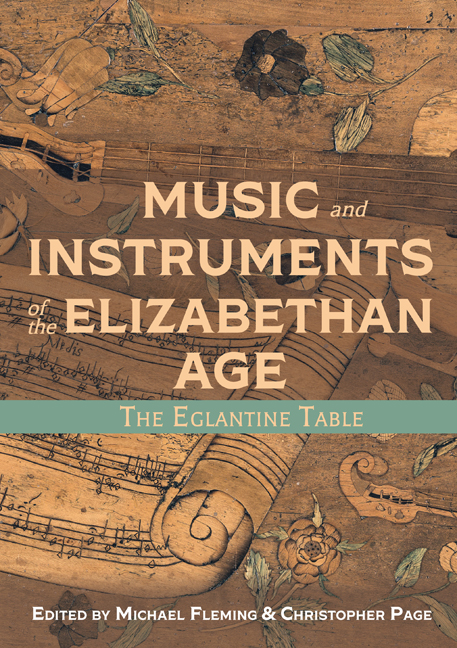Book contents
- Frontmatter
- Dedication
- Contents
- List of Illustrations
- Foreword
- Acknowledgements
- Note to the Reader
- List of Abbreviations
- Introducing the Eglantine Table
- Part I Silent Things
- Part II Music and Instruments
- Part III Broader Views of the Eglantine Table
- Appendices
- Glossary
- Bibliography
- List of Contributors
- Index
- Plate section
12 - The Harp
Published online by Cambridge University Press: 24 March 2021
- Frontmatter
- Dedication
- Contents
- List of Illustrations
- Foreword
- Acknowledgements
- Note to the Reader
- List of Abbreviations
- Introducing the Eglantine Table
- Part I Silent Things
- Part II Music and Instruments
- Part III Broader Views of the Eglantine Table
- Appendices
- Glossary
- Bibliography
- List of Contributors
- Index
- Plate section
Summary
Tucked behind the neck of a lute, the harp on the Eglantine Table almost seems to be in the background, yet it occupies the centre of frieze A, which is devoted to music and musical instruments (Plate 10). The harp was admired at court in the fifteenth century and in the first half of the sixteenth. Harps were played at the wedding of Prince Arthur to Katherine of Aragon in 1501, and Henry VIII is depicted playing a harp in his personal psalter of 1540–1, the work of the French scribe and illuminator Jean Mallard. The harp would have been a familiar instrument to Bess of Hardwick, for her domestic accounts during the time of her marriage to Sir William Cavendish, her second husband, include payment for a harp in a ‘case of lether’ for Sir William. By the early years of the reign of Elizabeth I, however, harp-playing at court had generally waned in favour of the lute, and there would not be a resurgence until the early seventeenth century, following the emergence of harps of newer design. Medieval and Renaissance harps were associated with a long tradition of narrative song in Britain, including metrical romances and narrative balladry, that had come to seem – considered as performed material – old-fashioned and low-class in the elite circles of Elizabethan England, though the texts of such material were still widely read, and were often printed. The culture at court had also shifted from a late medieval emphasis on the ceremonial and chivalric associations of the harp as an instrument for the court amateur, especially for the accompaniment of love-lyric, towards newer methods and music: consorts of viols, pavanes and galliards and, notably, polyphonic music intabulated for lute. William More (d. 1565), one of a long line of English court harpers extending back through the medieval period, was not replaced until forty years after his death, with the employment of the Irish harper–composer Cormack MacDermott in 1605. Perhaps it is significant, therefore, that the depiction of the harp on the Eglantine Table is partly eclipsed by the lute.
Very few European harps survive from before the seventeenth century, and none from Tudor England, so depictions in pictorial sources are of historical importance and interest. Does the Eglantine Table show a Tudor harp?
- Type
- Chapter
- Information
- Music and Instruments of the Elizabethan AgeThe Eglantine Table, pp. 171 - 180Publisher: Boydell & BrewerPrint publication year: 2021

